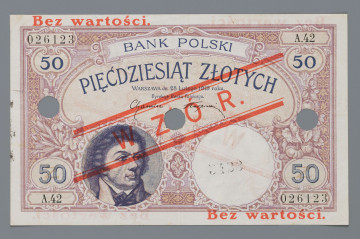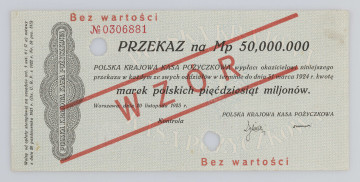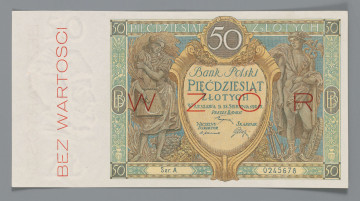
50 zlotys – a template
1919
National Museum in Lublin
Part of the collection: Paper money during the Second Polish Republic
One of the most interesting issues in the history of Polish money is the history of the zloty. Formally it became the binding currency in Poland only on 28 February 1919. At that time, the Sejm passed the act ‘On the Name of the Polish Coin’. That does not mean, however, that the history of the zloty started only after the World War I. The name of the currency appeared as early as in the 14th century. Already in the 14th century the name appeared to describe coins minted from gold. Since at that time Poland did not mint its own gold coin, the term became attached to foreign money. In 1496 at the Sejm in Piotrków it was decided that such coins would have a rate equal to 30 silver grosze. Due to the growing price difference between gold and silver, this exchange rate did not last and the name zloty started to be used in two senses. One included the conversion unit of 30 groszy (Polish zloty), the other referred to foreign coins called red zlotys. The red colour in the name comes from the fact that most often delivered to Poland Hungarian florins contained an admixture of copper to harden the alloy.
The first Polish coin which corresponded in value to gold was the ’półkopek’ minted during the reign of Zygmunt August. The so-called light thalers of Sigismund III Waza were also called gold coins, while the first coin whose rate was fixed at 30 groszy was the ‘tymf’, minted from 1663. For that reason, it may be regarded as the first gold coin. Since the monetary reform of Stanisław August Poniatowski in 1766 the zloty rate was set at 4 silver or 30 copper groszy. Despite the fall of the First Republic, the zloty was present in the currency system of the Duchy of Warsaw, and later of the Congress Kingdom, until 1841.
Such traditions were inherited by the zloty introduced as the currency of reborn Poland. Among many banknotes of the first issue of 28 February 1919, there was also a ten-zloty banknote. Like the other banknotes of this issue, it did not enter circulation until 28 April 1924. That was due to economic and political difficulties in the first years of independence. The ten-zloty banknote was printed by the graphic works of the Bank of France, the graphic design was created by the studio of professor Egène Gaspé. The author of the general design was Adolphe Giraldon. The woodcut of the obverse was made by the engravers Emile Deloche and Charles-Julien Clément. The woodcut of the reverse was the work of the studio's director, Egène Gaspé.
Leszek Poniewozik
Author / creator
Dimensions
cały obiekt: height: 149 mm, width: 89 mm
Object type
paper money
Technique
Material
paper
Creation time / dating
Creation / finding place
Owner
The National Museum in Lublin
Identification number
Location / status

1919
National Museum in Lublin

1923
National Museum in Lublin

1925
National Museum in Lublin
DISCOVER this TOPIC
National Museum in Szczecin
DISCOVER this PATH
Educational path